
-- A Cyberspace Review Of The Arts
Volume 20.04
June 14, 2013
|
The Battle of Petrosino SquareA war of sorts has broken out between two improbable belligerent parties around a little-known pocket park in Lower Manhattan, Petrosino Square. On the one side are some of the immediately local residents of the rather unusual neighborhood that surrounds the park; on the other, the Greenwashing Department of Citibank. The central issue is the Citibike installation in the park's plaza, which has preempted a space intended and used for large public works of art.
First, a little geography, history, and dramatis personae: Petrosino Square, is named for a heroic character of of yesteryear, Lieutenant Joseph Petrosino, who was active around the beginning of the 20th Century and was the first New York City police officer to die in the line of duty outside the country (he was killed in Palermo, Sicily, in 1909, during operations against the Mafia or Black Hand). It is a small triangle formed by the junction of Kenmare Street, Lafayette Street, and Centre Street, with its apex at Spring Street, just north of the old Police Headquarters in Lower Manhattan. Since it is too small to build on, it has contained a tiny park for many decades. Out of the way of the storms of Manhattan development and destruction frenzies, even a few dusty trees grew.
People who were around back in the day will remember when this area was considerably scruffier than it is today; it was part of Little Italy, and as the Little Italians moved to the suburbs it became increasingly derelict, which was going some. It became a place where people moved because the rents were low, the neighborhood quiet, the rich and their business far, but not too far, away. (One needs work, clients, buyers, as well as low rent.) The city was happy to ignore the inhabitants and the park, and so it spent a few decades gently deteriorating. In the realm of the arts, back when officially sanctified art was up on 57th Street, some of the now-famed 'Downtown Scene' occurred around here. Bohos lounged, artists did art, Happenings happened, the savvier tourists came by. Otherwise, most of the time, Petrosino Square was just a place where where a weary wino, street person, or local minimum-wage slave could rest from his labors for a while without being told to move along.
In the last few years, however, the area has been radically assaulted by gentrification, part of the Soho maelstrom. And the city fathers and their big-ticket real-estate friends do not want the high-rent-paying, condo-buying, much-better- off-thank-you people who have descended on the area to have to put up with scruffy parks or scruffy people. Therefore, the park was shaped up and made quite spiffy. Some of the trees were allowed to remain in a fenced-off section; the rest was turned into a sort of plaza, that is, an open area paved with large elegant bricks. For a time, the plaza-like part of the revamped park became a site for the installation of large public works of art, perhaps as a sort of nod to the now-fading cultural history of the area (which nevertheless still houses many artists, bohemians, and cranks from the old days hanging on here and there, not yet all kicked out.) Concerned neighbors were assured that this was its intended future use.
One of the holdouts of the old order has been Minerva Durham, who has operated Spring Studio in a basement on, of course, Spring Street for the last 20 years or so. At Spring Studio people mostly do Life Drawing, that is, they draw pictures of naked people, an ancient tradition which has had a considerable revival with the resurrection of figurative art. (Full disclosure: I am one of these people.) Minerva Durham is cool enough to have been mentioned in a David Sedaris story. She is a very active participant in local matters; for example, she and several other residents and business proprietors vigorously objected to and thus blocked a pseudo-pushcart in the park intended to sell upscale goodies, as if there weren't already a dozen upscale-goodie stores within a hundred feet or so; Starbuck's is right down the block. Although the mallification of the city has mostly overrun much of the general area, Minerva and her allies reasonably thought they could defend at least this little oasis of noncommerciality. But in late April, His Excellency Mayor Bloomberg, some people at Citibank, and some other entrepreneurs of the new new world, suddenly and arbitrarily repurposed the plaza of Petrosino Square: it has now become totally a landing area for the commercial operation of the rent-a-bike racks we have all heard a lot about, a sort of gigantic billboard with little detachable billboards you can ride around on for a price. Most such installations have taken up street space formerly used for parking cars, but an actual park is a something quite different, and I think its arbitrary appropriation reveals the principles of the Citibike operation, which are not to supplant motor vehicles with bicycles but to pull off some kind of greenwashing commercial or public-relations stunt on behalf of those who are financing or enabling it. After all, if the city had wanted to encourage cycling beyond painting lines on the street, they could have long since installed non-commercial bike racks in these same parking spaces, and told the police to dial back the very special attention they have been giving to non-commercial cyclists in recent years. The fact that a bank would choose bicycles to do greenwashing duty is not at all surprising. There is a process sometimes called appropriation in which a practice started by marginal people is taken up by those who are 'better' and more important, and institutionalized -- made part of the state -- often to the exclusion of the very people who began it. Sometimes appropriation is merely the adoption of an attractive idea, but often it is accompanied by a vague redolence of righteousness deriving from its origin among the lowly (which doesn't include inviting any of them along). Back in the 1960s, for example, 'hippies' and other slum children voluntarily cleared out some vacant lots and made gardens out of them, some of them, real horticultural works of art. Real estate people were not slow to notice these projects improved 'values' (that is, increased the rents and sale prices they could get from buyers and tenants). The authorities and their powers were rung in. Now, many of these gardens have strong fences around them, with locked gates, open only to a select membership, and certainly not to scruffy, low-rent hippies; some have even been taken into the City Parks system and are managed by it. Another example: Food Not Bombs handed out food to people in parks and other public places; they were soon imitated by City Harvest, and it was made illegal (in theory) for the unorganized and unchartered to give people free food. And bicycles, which were once used almost exclusively by deliverymen, messengers, and other poor people, under the pressure of a deteriorating environment, have become every politician's and bureaucrat's favored choice of transportation for other people. There is even a second, more specific appropriation here: the idea of shared bicycles clearly descends from the white bicycles of Amsterdam, which were left on the streets for free use by hippie anarchists in years gone by. No free-stuff anarchists need apply to the present operation, however! In the presently succeeding stage of appropriation, privately-owned bicycles are now going to have to make room for advertising-laden corporate bicycles ridden by fee-paying users. Criticism is to be deflected by the 'green' aura that has been attached to the bicycles; if you're against anything the city and Citibank have done, as, for instance, billboarding Petrosino Square, you must love giant SUVs and the presumably piggy people who drive them. And you have been officially tut-tutted by the Editorial Board of the New York Times, no doubt a terrifying fate if the Times is your daily scripture. All this should catch you up on the particulars of the present drama. The next voice you hear will be Minerva's. This is a letter which she sent to the media and various persons and organizations concerned with the issues shortly before the racks were loaded and opened for business.
Since Saturday, April 28, I have been protesting the theft of the art installation space in Petrosino Square by the New York City Department of Transportation and Citibank. The City administrators and the corporate bank have placed bike-share docking stations on top of the officially designated space for Public Art. Georgette Fleischer and I had stopped the bike-rack installation on Thursday night, April 27th, but DOT secretly placed the racks during the middle of Friday night. If bikes are operating from the stations on Memorial Day weekend , Saturday, May 25, I will lock Spring Studio for one week or until the bikes are removed, whichever comes sooner. In good weather I will have classes outside with a nearly nude or nude model, depending upon the model's fearlessness. I will leave messages on the phone, 212-226-7240 about the times for the sessions in the park. I will have all of the morning classes in the park if it is not raining. They will be free to anyone who wishes to draw. I will also bring free materials for passersby. The studio will be open for Karen Capelluto's show during the gallery hours, 5:00 to 6:00 pm, M-F. If the bikes remain I will reopen downstairs on Saturday, June 1, raise the prices, and cancel all plans to stay in New York City beyond the two-and-a-half years left on my lease here at 64 Spring Street. The historic reasons for an art installation space here in this Park are overwhelming. The fact that the Park was derelict in appearance but inviting to avant-garde and experimental artists since 1985 makes it a sacred place for everyone who is aware that their artistic output was influenced by the Fluxus movement. Just about everyone who makes art today, as well as most performing artists, express Fluxus ideas.. Think of Lady Gaga and her elaborate settings. Even the newspaper reports of my protest are couched in Fluxus concepts and language: "Elizabeth Hellman's ballet-inspired protest..." and "In typical SoHo artist style, a woman is staging a protest near the bike rack, standing in a statuesque pose every day..." I love these descriptions that assign empowerment to the performer herself, to the genuine and truthful intention of an artist who moves and communicates. That vision of the artist comes right out of SoHo. The idealistic thrust of the artists' settlement in the loft buildings in the cast-iron district was central to the economics and politics of Virginia Admiral, the woman who organized 226 Lafayette in the early 1970's. It is thanks to her, my friend who died in 2001, that I have my business in the basement here. Before she died, she said,"Keep Minerva in the basement," a statement that could be viewed with sisterly cynicism or with a sense of humor that knows the value of real estate. The corner of Spring at Lafayette is to me the most valuable real estate in the world. But it will lose all of its value and charm if it becomes a bicycle depot. How did I get to be so lucky to have spent 21 years working on this corner? Now that the city has changed so much, is it time for me to go away and die in a obscure corner? Virginia wanted the Park to be green. She meant plantings. It took years for the Park to be rebuilt into the inviting space that it is now. The decision was made to put art works out in the "PLAZA" area, and to leave the fenced-in green area quiet, free of even artistic speech. Outside, in the north triangle, people gathered around the first work installed and took pictures in a touristy way without annoying the locals who live and work here and who sit in the enclosed green space. Actually, I think that most of the locals were proud that tourists were enjoying the art. There are many Parks Department papers proving that the north triangle of Petrosino is designated for temporary art exhibitions. Besides the historic, philosophic, and esthetic arguments for the removal of the bike stations and for the insistence on the continued presence of Art in Pertosino Square, there is a more profound and potentially more volatile reason to keep bike shares out of the park. For me it is the ultimate right-of-way turf war. I have been walking along the side of the park for over thirty years. For twenty of those years I have walked to my business at 64 Spring Street. I have rarely encountered mounted bicyclists on the pavement. If the bikes are being parked and taken out, my pleasant walk to work will become a hazardous journey. Already, the presence of the bike racks has opened up the possibility to many riders that they may ride on the sidewalk which is Park land and not a bike path. As I do my protest daily, I call out to mounted riders to "please walk your bike." One man stayed on the sidewalk, still mounted, then circled back in the street and called out to me, "I know you. I used to live where you live at 86 Kenmare, and you are easily the most annoying person in world." Half an hour later I saw him riding in the street in the bike lane and we both smiled and waved at each other. Another said that I need to get laid. (Everyone needs to get laid.) My problem is with Mayor Bloomberg, the DOT and Citibank. While many people are working on this, I feel that I have my own little war with them. It is either them or me. And, hey, he spends his weekends in Bermuda, while I am here all week long, and the weekends too. I was willing to go to jail to stop the pushcart from operating in the park, but I will die for this outrageous violation of the law and of the will of the local residents, both renters and owners of property, and shopkeepers who share with me the traditional cultural values of New York City. I am asking you, all the people I know and love, all of those who love the studio, to support the accomplishments of the art movement that occurred in SoHo at the end of the last century and to insist to Mayor Bloomberg, the DOT and Citibank that Petrosino Square be protected from commercial activity and from moving vehicular traffic (bikes), and that its front triangle be supported as the Parks Department has designated it to be, as a space devoted to art installations. I am asking those of you who have power and connections to do what you can. If you can't help me in this, I will have done everything in my power, and I will be living with a deep sense of disappointment and disillusion. Thank you, Minerva Thus far Minerva's activism -- besides inspiring the local Community Board to protest, and bringing in the local media -- has been to hold drawing sessions in what's left of the park, and, the attention of passers-by, tourists, and residents thus drawn, has passed out leaflets and gotten many hundreds of people to sign petitions. Thus far nothing has had any visible effect on the city administration; after all, few things unaccompanied by great power, wealth, or celebrity do, even when only a piece of a little out-of-the-way park is at stake. But the battle is hardly over. What does the future hold? There are various competing forces impinging on this little park. Gentrification, of course, sweeps all before it. But in the broadest context, American capitalism and empire are losing their grip and are being sustained mainly by energetic money-printing, a tactic which cannot be sustained indefinitely, although it has certainly inflated the equities markets and kept New York City real estate 'values' from collapsing. On the other hand, the deterioration of the American economy in the past has actually helped New York City, as the better-off fled the Rust Belt and other sloughs of despond to come to the remaining bright lights and casino economy of Manhattan. The gentry who are already here may be displacing the ancien regime of Bohemia, but they presumably moved to the area for its 'colorful character', not to be close to a Citibank billboard. They will have divided feelings which may be transmitted upward. The bureaucrats may dig in their heels as a matter of sacred principle, but they don't really have much to fight for. In any case, unless there is a fix in, that is, city submission to someone with influence and power who strongly opposes the bike racks being in a particular place to which they might be moved if they were not left in the park, it would seem to be a simple matter to move them a few hundred feet or less up or down or across Lafayette Street. Perhaps it is the very simplicity and reasonableness of this solution which keeps it from being employed.
|
||||||||||||
|
|
||||||||||||
|
|
||||||||||||
|
text and pictures by Gordon Fitch, 2013 |
||||||||||||
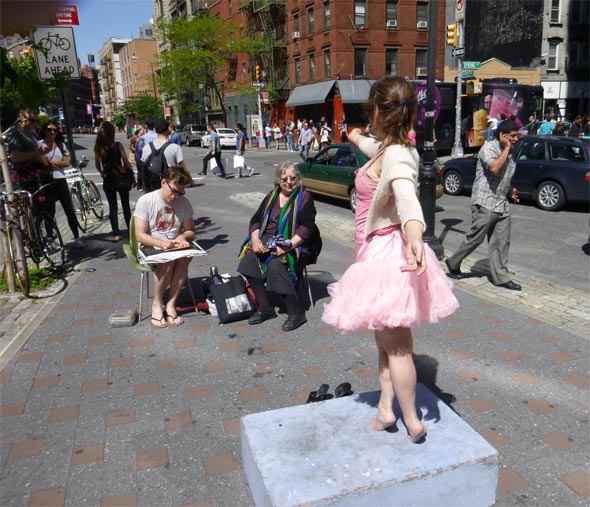
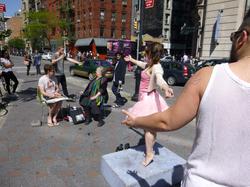
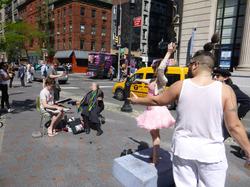
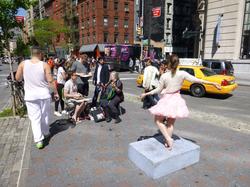
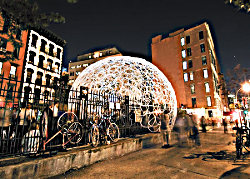
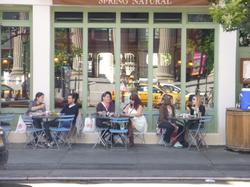

 Back to the Front
Back to the Front